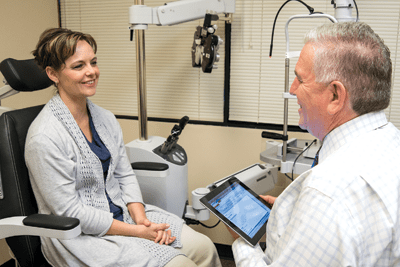Medical home – it sounds like a place, but in reality it is a healthcare model that puts the patient at the center of a team of healthcare professionals, led by the primary care physician. According to Jackie Ross, manager of Health Home Support for Legacy Health Systems, patient-centered medical home (PCMH) has a “triple aim – better customer service, better quality, lower cost.”
Principles and results
PCMH, said Dr. Prasanna Krishnasamy, a primary care physician who teaches internal medicine at Legacy’s Emanuel Clinic in Portland, is in stark contrast to the traditional disjointed model, where a patient sees a primary care physician and any number of specialists, but no one is “running the show.”
The traditional model, said Krishnasamy, is prone to error, such as negative interactions between medications, and can lead to duplicate care, such as two specialists running the same test. Also, it emphasizes seeing the maximum number of patients, but not necessarily in a “meaningful manner.” PCMH attempts to solve these problems by creating a healthcare team that consists of the primary care physician plus other experts such as a case manager, pharmacist, nurses, nutritionists, social workers and mental health resources, and various specialists such as cardiologists or oncologists.
According to Dr. Kelley Aurand of Legacy Medical Group’s Fisher’s Landing Clinic, the team’s medical assistant and nurse case manager reach out to patients, reminding them of overdue preventative care such as lab tests and cancer screenings, helping them with prescription refills, and providing extra support to chronically ill patients.
Dr. Tony Daniels, Kaiser Permanente NW’s primary care service area director for Clark County, said the team approach also benefits primary care physicians. Daniels said primary care can be “daunting,” due to the convergence of several factors: the explosion of technology, ongoing education about medical procedures, a growing geriatric population with inherent medical issues, and an exponential expansion of required documentation and coding.
“Medical home addresses a lot of that – especially with complex cases,” said Daniels.
Many of the region’s healthcare providers are moving toward PCMH. For example, Ross said that starting two years ago, all new Legacy clinics are opened as medical homes. Dr. Marilyn Darr, of PeaceHealth Southwest’s Family Medicine Residency Program, said their program received PCMH certification last year from the National Committee for Quality Assurance (NCQA).
Daniels said that Kaiser has “been doing PCMH for a long time, but weren’t calling it by that name.” When the model became better defined, he said, all 17 regional clinics received the highest NCQA rating two years ago.
“It was an easy transition to meet the definition,” said Daniels.
According to local care providers, PCMH can indeed meet that triple aim referenced by Ross. She said that in a recent six-month pilot that focused on “frequent flyers to the emergency department,” PCMH “reduced both utilization cost and number of visits by 50 percent.”
At PeaceHealth’s residency program, said Darr, about 75 percent of the patients are on Medicaid and have “a lot of care gaps.” PCMH, she said, is enabling the program to keep at least 30 percent of the program’s 1,000 diabetic patients’ metrics in the target range.
“We’re getting there…we’re figuring out gaps and barriers,” said Darr.
Hurdles and challenges
Dr. Larry Neville, Columbia Network vice president for the PeaceHealth Medical Group in Longview, summed up the barriers to implementing PCMH as “cost, effort and mindset.”
“It requires a more varied staffing model and a richer ratio between provider and support staff than is typical,” said Neville. In addition, said Kelley, a care provider’s electronic health record (EHR) is “part of the team,” because it provides the necessary data to enable coordinated, proactive care – but these systems are expensive to install.
Darr said that the recent explosion of data available from EHRs is what has brought PCMH to the forefront. The concept has been around since the 1960s, but only in the last 10 years have physicians had access to enough data to implement the model in a practical fashion.
“Conceptually, it’s old-hat,” said Neville. “Operationally, it’s new.”
Krishnasamy referred to another barrier – a disconnect between the current fee-for-service payment model and PCMH’s holistic approach to care. Ross said that “most of our carriers have bought into the model, so are having conversations around how payment methods need to change.”
According to a recent article published by the American College of Physicians, a three-part payment model should replace the traditional payment model: a monthly bundled care coordination payment; a visit-based fee-for-service component; and a performance-based component.
Besides the tangible costs associated with implementing PCMH, it also represents a culture change.
“Providers are thirsting for what feels like more authentic medicine,” said Neville, “but it’s giving up of control – you have to learn to trust the members of your team.”
Kelley agreed, stating that “a lot of primary care residencies are training for PCMH, but it is a huge shift in culture for older doctors.”
And, said Daniels, recruiting enough primary care doctors to meet the demand is a significant challenge. Darr said that the United States is behind worldwide industrialized countries in terms of the ratio of primary care doctors versus specialists. Worldwide the ratio is 50 percent, while in the US only 30 percent of physicians practice primary care.
“The shortage is still very real and is a worry for everybody,” said Daniels.
To address the problem, he said new medical schools are being built, and “at the local level we are adjusting our systems to make being in primary care sustainable and enjoyable.”
“As we move ahead with medical home, it will make the sustainability of primary care better and better,” stated Daniels.
Neville said PCMH will also serve to protect the “unique and beautiful relationship between patient and doctor” in the midst of ongoing consolidation in the healthcare market.
“I’m looking to medical home to be the soul of these larger entities – otherwise they might become corporations and nothing more,” said Neville.



